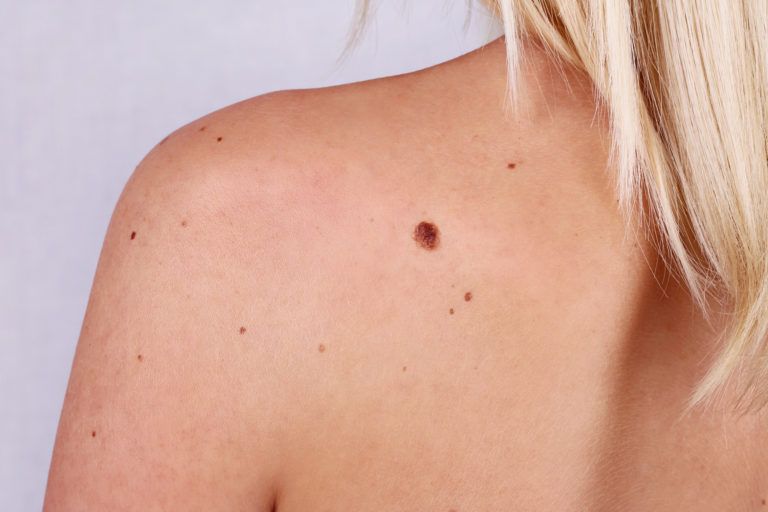
Beauty standards are a fickle thing. There’s a very good chance that at some point in history everything you might consider ugly or unfashionable now was once the height of fashion. That mole on your cheek that you hate? Remember Marilyn Monroe’s beauty spot? Or Cindy Crawford? They were good lookin’ women, but if you’ve got strong feelings about your own beauty spot, you will want to know how to get rid of a mole. So read on!
Regardless of whether or not they’re fashionable, moles (nevi) are part of the human body. Everybody has moles (anywhere from 10-50 usually), which are localized growths of skin pigment (melanin) with a growth cycle of about fifty years (most people aren’t born with moles). Moles aren’t necessarily raised growths (although many are), and can look very similar to other melanin growths (like freckles), ranging in color from pink to brown to black. Whether you’re getting rid of a mole for aesthetic reasons or health reasons (see last paragraph),read on for suggestions for common ways to get rid of a mole.
Best Types of Mole Removal
Plain and simple surgery can remove a mole quickly, with relatively little pain.
By far the most common method of getting rid of a mole is a quick surger during which the physician numbs the mole and surrounding area, then shaves off or cuts out the offending mole with a scalpel and stitches the wound closed. Often painkillers are prescribed while the wound heals, and minor scarring is possible.
Electrosurgery is another way to get rid of a mole.
Again, the physician will remove the mole with a scalpel, but s/he will also use an electric needle to destroy the deeper tissue below the removed mole. This way the mole will be gone, with no chance of growing back. Stitches aren’t always necessary with this procedure, but some scarring is still possible.
Laser surgery is an effective way to get rid of moles.
Usually performed by a dermatologist, the doctor will numb the area around your mole with a local anesthetic, then destroy the nevus tissue, with minimum damage to the surrounding skin tissue. Skin usually takes 1-2 weeks to heal after laser resurfacing, and long-lasting results will be varied.
Liquid nitrogen treatment (cryotherapy) can get rid of moles.
Also known as “freezing” (because it’s so cold—duh), liquid nitrogen is also a common treatment for warts and freckles. When applied directly to a mole, the liquid nitrogen will destroy the cell tissue and get rid of the mole. Cryotherapy can be painful and cause scarring, and should not be used on the same area skin more than once a week. Amazon sells Dr. Scholl’s Freeze Away for warts. Though you’ll want to check with a doctor before use.
There are prescription or OTC products that contain tissue-destroying acids to get rid of moles.
If you don’t want to have surgery, talk to your dermatologist or physician about this option — just remember that using these products to get rid of a mole is a long process (up to six weeks) and the acids will destroy any skin tissue they contact, so there’s a big potential for further skin damage.
Medication for Moles
Sometimes moles (nevi), or other dermatological condtions like freckles and warts, can turn into something more serious. Larger flat brown spots can be the result of aging (often called age spots); rougher large brown marks can be sun damage (solar keratoses) or warts. A that mole that is larger than average and/or grows quickly and becomes discolored or unevenly with an irregular shape is probably a dysplastic nevus (abnormal mole). If you find any abnormalities in your moles you should see a doctor immediately to check for malignanst melanoma, a common form of skin cancer.
Best Natural Mole Treatments
Because a mole is a natural growth of skin cells,
“unnatural” means of removal (like surgery or chemical) are the most prevalent. There are, however, “natural” or organic treatments available. We make no guarantees, but you can try the natural oils H-Skin Tags removal formula sold at Amazon.
Preventing Moles
To prevent your moles or freckles from becoming a more serious dermatological condition you should avoid prolonged sun exposure. So wear a hat, long sleeves, and long pants; stay in the shade; and always wear sunscreen with a minimum SPF of 15 that blocks both UVA and UVB rays. Sunscreen is especially important if you’re treating your skin for any dermatological condition—most skin treatments and even some dietary supplements (such as St. John’s Wort) contain chemicals or other ingredients that increase your skin’s sensitivity to light.